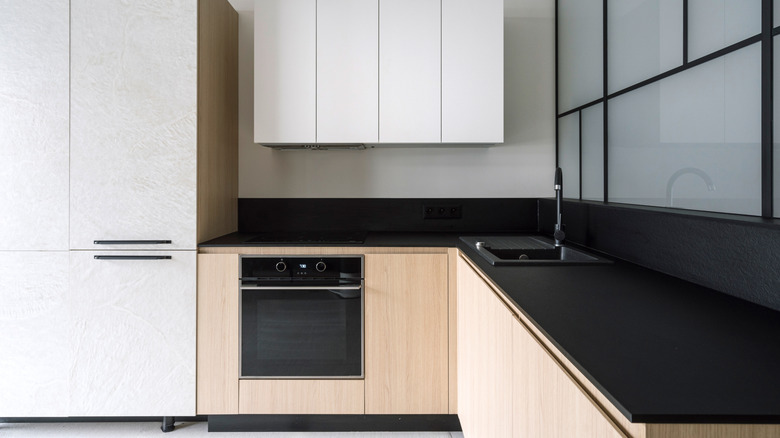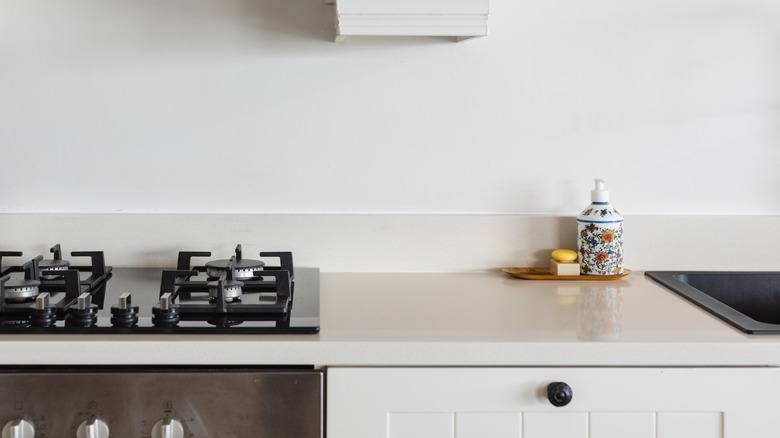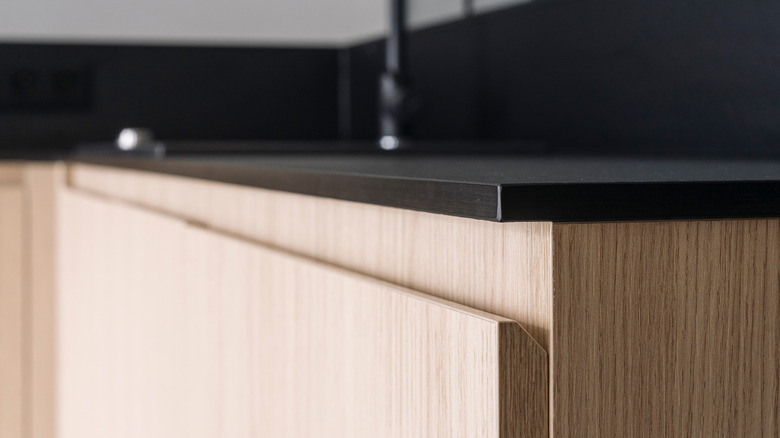The Right Thickness For Quartz Countertops If You're On A Budget
Quartz countertops remain popular for their aesthetics, durability, and ease of maintenance. In a House Digest survey of trendy countertops being added to homes, quartz came in second only to marble as the most wanted material. In addition to a broad range of colors and patterns, there are a few thickness options for quartz countertops, ranging from 1 to 3 centimeters. Slim-profile quartz may be the right thickness for attractive, budget-friendly countertops. Three-centimeter thickness is standard for quartz countertops, but slim-profile quartz countertops are available as little as 1 centimeter thick. Homeowners on a budget often choose 1-centimeter slim-profile quartz as a cost-effective solution for their new countertops.
Slim 1-centimeter countertops have a profile that provides a minimalist aesthetic and fits well in modern and contemporary designs. Of course, there are advantages and limitations of the thinnest slabs. If you want to swap your outdated laminate countertops for a trendier alternative like quartz, understanding the advantages and disadvantages of slim-profile quartz can help you find the ideal stone for your application.
Advantages of slim profile quartz
If you are looking for a cost-effective solution for your new countertops, thinner quartz can provide elegance at a more affordable price. Because the slab is thinner, less material is needed to create your new countertop. Additionally, the installation process is faster and easier, which makes it more affordable. Although it is possible to DIY your quartz countertops, hiring a professional is recommended for several reasons. Quartz is heavy, requires the right tools for precision installation, and slim quartz may need additional support.
Quartz countertops can range from $2,000 to $6,000. Going from 3-centimeter to 2-centimeter quartz can lower the price by 25%, and a 1-centimeter thickness can save even more money. The cost per square foot of 1-centimeter quartz ranges from $45 to $70, compared with $75-$150 for 3-centimeter quartz countertops. The cost per square foot varies for 1-centimeter countertops due to the quality of the quartz and brand. The material grade, pattern uniformity, and imperfections influence the cost.
The thin profile of 1-centimeter slim quartz is versatile and suitable for countertops and other applications. This type of quartz is often used for fireplace surrounds, backsplashes, wall cladding, and other vertical applications. Matching the type of quartz used in different areas of the room offers continuity of design throughout the space.
Limitations of slim profile quartz
Consider the limitations of slim quartz countertops, as well as the advantages, to make an informed decision. Thicker slabs offer more options for profile edges than slimmer slabs, which may be limited to squared and other standard edge profiles. More intricate designs for the profile edges aren't possible with very thin slabs. The amount of weight quartz countertops can hold varies, depending on the thickness. Three-centimeter quartz countertops can hold up to 1,000 pounds, while thinner quartz can hold much less weight.
Another limitation is the fragility of slimmer quartz slabs. The slimmest quartz is going to be damaged more easily, which makes it less than ideal for kitchen countertops. For this reason, you may want to save the thinnest quartz for bathroom countertops. If you want to use 1 centimeter for the kitchen, additional support will be needed for sufficient durability. Inadequate support can result in small cracks, movement, and visible sagging.
Keep in mind that while 1-centimeter quartz may be cheaper upfront, it may not be a good long-term investment, due to its fragility. When selecting new quartz countertops for your home, it is helpful to know the best and worst types of countertops for your home's resale value. The best way to ensure that your new countertops work for now and into the future is to select a neutral color in the thickness that is best for your application and budget.


